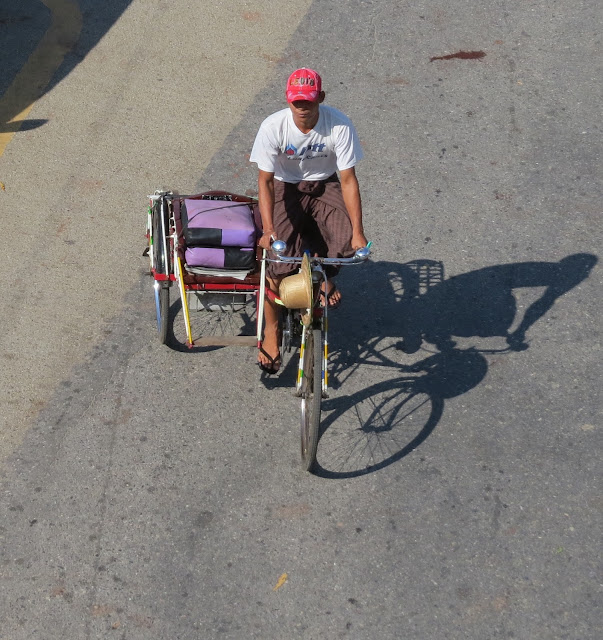Last week there was another public holiday in Singapore, Deepavali, we added a couple more days to the long weekend and flew to Myanmar (previously called Burma) for 5 days. We had decided rather than pack too much in to our schedule we would instead concentrate on exploring Yangon (previously known as Rangoon) and the nearby area.
This was my first visit to Myanmar (Papa T's 3rd but the previous 2 had been solely for business not sightseeing ) and I was really excited. We arrived in Yangon early in the morning and after checking into our hotel headed straight out to explore.
Yangon is Myanmar's largest city, there are few high-rise buildings (as yet) and the first international style shopping mall opens next month. There are no Starbucks, MacDonalds or other restaurant or clothing chains. Many of the buildings date from colonial days and some of them are very dilapidated. The streets are full of people, bicycles, jam packed very old and rickety buses, taxis (very few with working seat belts) and cars (mainly old but also some shiny new Japanese makes) street hawkers, pavement cafes, monks and lots of street dogs
Almost 90% of Burmese people classify themselves as Buddhist and there are pagodas, stupas monks and shrines everywhere. Outside the temples we saw cages full of "Luck Birds", the idea being that you buy the bird and set it free, this act acquires you merit for 'saving a life', however I couldn't help feel sorry for the poor birds which are caught in the wild and crammed into cages, apparently many die because of fright or injury before release.
We stopped to visit Chauk Htat Gyi Pagoda where a 66m reclining Buddha resides, as well as lots of dogs relaxing in the temple precinct
This Buddha seems to have a rather feminine looking face with his blue eye shadow and red lips and the most fabulous soles to his feet covered in 108 auspicious golden markings

This lady was pouring water over the Buddha statue at her 'planetary post' (the day of the week she was born on). She will douse it with water once for every year of her age plus once more for luck

A number of the statues had bright flashing lights behind them- rather garish we thought
We carried on to our next stop and one I had been most looking forward to; the Shwedagon Pagoda, reported to be Myanmar's greatest temple and one of the world's most majestic Buddhist monuments.
The taxi dropped us at the foot of one of the four covered staircases leading up to the pagoda. At all Buddhist sites you must take off your shoes and socks, this young lady was very persistent so we relented and bought a plastic bag (200 Khat, approx 10p) to carry our shoes in
On her face she wears Thanaka, worn by many women, children and some men. Made from tree bark, ground into a paste it is applied to the face and works as a suncream, perfume and decoration.
The stairway was lined with shops selling religious souvenirs, incense, flowers etc
Shwedagon pagoda towers over Yangon and we were lucky enough to be able to see it from our hotel bedroom but I had no idea as to how large the site it sits on is and close up it looks even more magnificent. The stupa is 99m high and was gilded using nearly 22,000 gold bars.
Near the top is the Hti (umbrella) said to be set with 5448 diamonds, 2317 rubies and 1065 golden bells, as well as sapphires and other gems. On top of this is a single 76 carat diamond set to catch the first and last rays of sun at dawn and dusk.
Zooming in we also spotted a hawk sitting just below the hti, he had a great vantage point
The terrace surrounding the stupa is full of shrines
The older monk was happy for us to photograph him and his young friend whom he said was an orphan. Myanmar has nearly half a million monks and about 50,000 nuns at any one time. It is expected that all boys will enter a monastery for a short time in their lives for religious education. We were told that many orphans will become monks or nuns so they receive education and a home.
We had found a young man to act as our guide and he explained that there are 8 days in the week in Buddhism with Wednesday being separated into 2. Great importance is given to the day of the week one is born on, and Buddhists pray at their relevant 'planetary post' and wash the Buddha image reverently. I was born on a Wednesday morning and was encouraged to pour water on the Buddha image. At each post there is a different animal at the base, Wednesday morning's animal is an elephant with tusks (Wednesday afternoon's is an elephant without tusks)
Our guide then spotted two monks on the stupa and explained that sometimes the gems fall out of their settings, maybe because of being pecked at by birds, so the monks regularly check the levels for fallen gems which can then be replaced
We then found Papa T's planetary post
and some temple bells. Striking the bells aides prayers to be heard
This Bell of King Singu, dates from 1778 and weighs 25 tonnes. In 1825 the British attempted to steal it, but their boat sank in the Ayeyarwady River. The bell was later recovered by the Burmese and replaced at Shwedagon
By now it was getting dark and the pagoda was lit up and literally shone in the night sky
We had had a wonderful first day, the Shwedagon is an amazing sight and the city was fun to explore. The next day we planned to find a more rural part of the Ayeyarwady Delta

































No comments:
Post a Comment